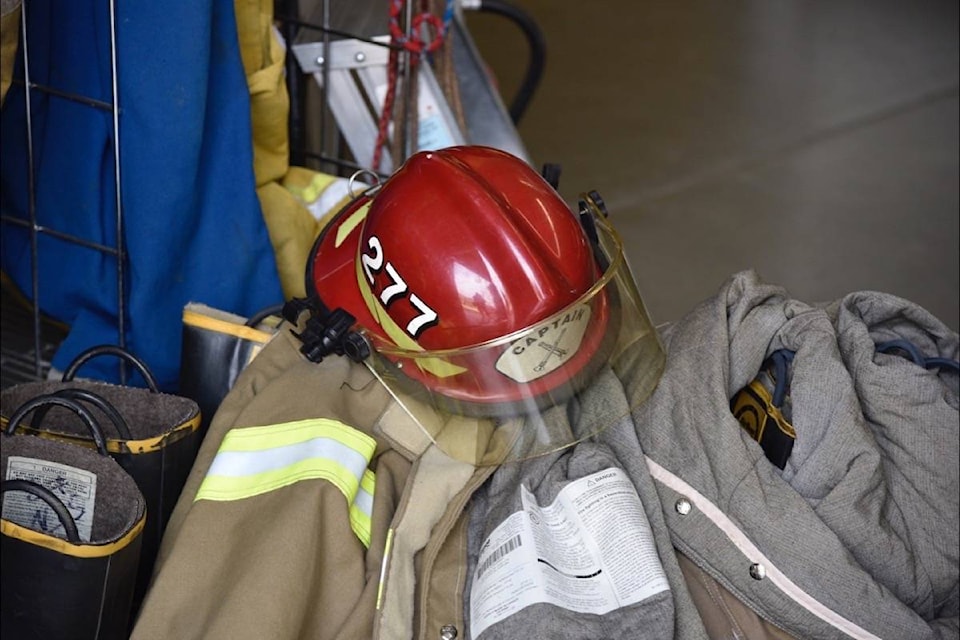In my job, the best days are the ones I spend out of the office. One of my professors once told our class that the news was never going to happen at our desks, so we’d better not be there.
That was never more true than Monday, when I got the chance to be a firefighter for an afternoon with members of the Grand Forks Fire/Rescue team.
While there is more elsewhere in the paper about the fire training grounds, I had some thoughts to share about my own experience getting all geared up and learning (some) of what it takes to be a firefighter.
When we arrived at the firehall, the first thing to do what get us situated with the proper gear.
The firefighters guided us though putting everything on, and in what order. Boots, pants, suspenders, jacket, balaklava, gloves and helmet. I instantly felt myself weight down with that gear – but of course where was still a breathing apparatus to come, and that’s when the fun truly began. I nearly tipped over backwards, and then it was off to the training grounds.
I have certainly been more graceful in my life than the moment I attempted to climb into the truck wearing 40 plus pounds of gear on my five foot frame. Thank goodness for helping hands.
At the fire training grounds we were shown through the live fire building; our exits, where the fire would be, how to stand to make sure you were below the thermal layer. Our firefighter guide calmly explained that we could expect temperatures of 500-600 degrees once the fire got going.
He explained to us how to use our masks properly: to regulate air flow, the masks provided air on demand. That meant you had to breathe in, and only that would trigger air flow into the mask.We would get used to the slighty claustrophobic sensation, he explained, but getting stressed out would make the air go faster, and our small (but still 25 pound tanks) would last for about 23 minutes.
Our fighfighter guide explained what we would see: as we we followed him in, everything would be orange-tinged as our masks fogged up. A few seconds later it would clear and we would see the flames, about four feet ahead of us. At this point we could leave if we wanted, but he would start showing us how to “knock down” the fire.
From there it got smokey; we could only see the faintest of outlines as the light from the fire subsided and smoke filled the space. He instructed us to listen closely to instructions and go out the same way we came in, one at a time, pulling the hose with us as we left.
After a break to cool down and have water, we gave the other props at the ground a try: the interior car fire, and the natural gas fire. I got to try the hose (and sorry again for the water I sprayed down the back of at least one firefighter’s neck).
It was explained to us that for every fire call, there can be as much as two hours of clean-up time when they get back to the hall. Even if they get back at 2 a.m, after an eight-hour house fire: they have to be ready to be called out again in a moment. That means air tanks refilled, masks cleaned and gear stored.
The experience was undoubtly a fun and unique one – according to the team, getting suited up and going into a fire was an experience no other non-firefighter had had, and more than some of the department’s newest recruits had had a chance to do.
Thank you to the department member who put in hours of time to take us through the demonstration, answering the silly questions without hestition and telling us ernestly that we did a really good job.
Like most people, I have always had the utmost respect for our firefighters and am thankful for the work they do.
But having put on the suit for an afternoon and being guided through the experience by many dedicated department members, I simply cannot imagine the dedication and commitment it takes to be called out of bed, away from family or work to put on that gear and fight real fires for hours and hours, year after year. My experience was nowhere near the real thing, and I can’t pretend to know what it takes. But it did shed some light on how very hard our department works to keep us safe, and for that I am thankful.
